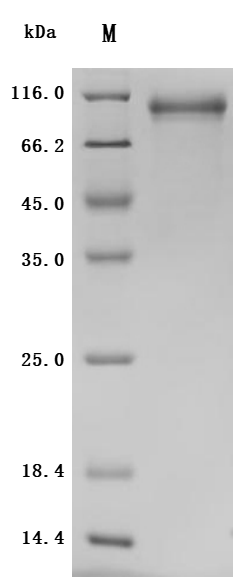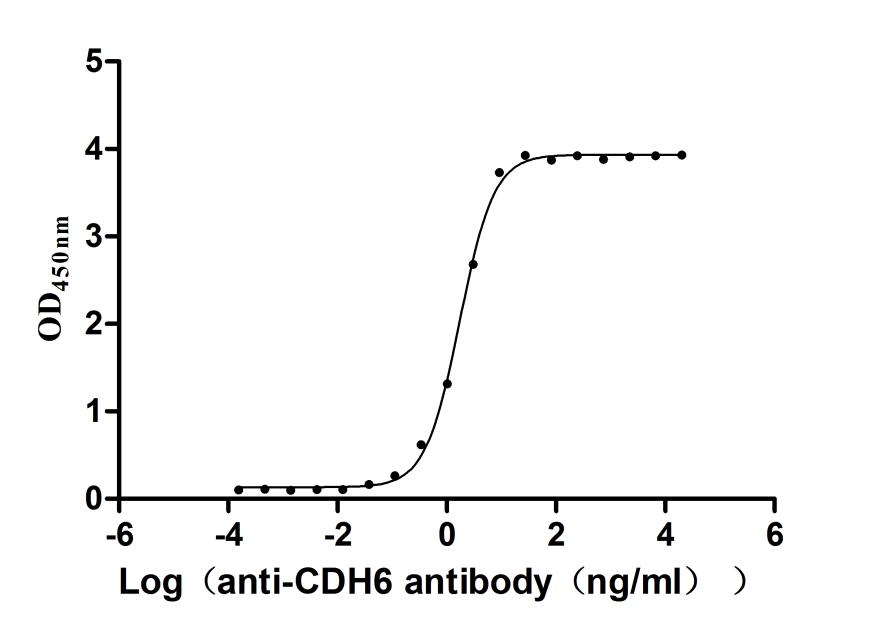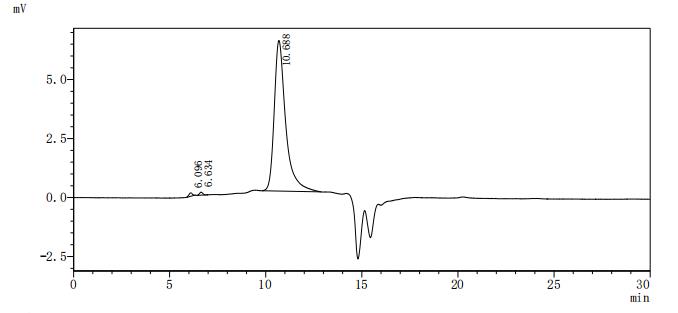This recombinant rat Cdh6 protein is an active, high-purity product expressed in mammalian cells to preserve native structure and function. It contains the extracellular portion of the rat Cdh6 sequence, covering amino acids 54 to 615, and is equipped with a C-terminal 10xHis tag to streamline purification and detection. The recombinant Cdh6 protein is supplied in lyophilized form and exceeds 95% purity, as confirmed by both SDS-PAGE and SEC-HPLC analyses. Endotoxin levels are tightly regulated, remaining under 1.0 EU/µg based on LAL testing. Its biological activity is demonstrated in a functional ELISA, where immobilized Cdh6 at 2 μg/mL binds specifically to the anti-CDH6 recombinant antibody (CSB-RA005055MA1HU), yielding an EC50 between 1.630 and 1.837 ng/mL. These specifications highlight its reliability for use in studies involving cadherin-mediated adhesion and antibody interaction assays.
The rat Cdh6 protein is a member of the cadherin family, a group of calcium-dependent cell-cell adhesion molecules crucial for maintaining cellular organization in tissues. Cdh6 is predominantly expressed in the renal system, particularly within the proximal tubules and glomerular parietal epithelial cells in rats [1]. This expression pattern suggests its significant role in kidney morphology and function. Indeed, studies have demonstrated that the deletion of the Cdh6 gene leads to abnormal kidney development, characterized by spontaneous tubule formation in animal models [1].
In addition to its role in kidney physiology, Cdh6 is implicated in various developmental processes. It has been identified as having a critical function during the morphogenesis of the central nervous system, indicating its importance beyond renal tissues [2]. Furthermore, its expression in rat brain structures like the hippocampus and the subiculum suggests that it may contribute to neuronal connectivity and organization [3]. Given its multifaceted roles, Cdh6 is vital in processes such as epithelial-to-mesenchymal transition (EMT), which is fundamental to both normal development and pathological conditions like cancer [4][2].
The potential pathophysiological relevance of Cdh6 is underscored by its association with various cancers. For example, Cdh6 has been analyzed as a candidate tumor suppressor in cholangiocarcinoma, where it is believed to modulate processes involved in tumor progression [5]. Moreover, its expression levels have been linked to tumor invasiveness and patient prognosis across several cancer types [6]. This illustrates that Cdh6 not only plays an essential role in normal biological functions but also has implications in disease contexts, particularly in kidney and cancer biology.
References:
[1] S. Gharib, J. Pippin, T. Ohse, S. Pickering, R. Krofft, & S. Shankland. Transcriptional landscape of glomerular parietal epithelial cells. Plos One, vol. 9, no. 8, p. e105289, 2014. https://doi.org/10.1371/journal.pone.0105289
[2] V. Sancisi, G. Gandolfi, et al. Cadherin 6 is a new runx2 target in tgf-β signalling pathway. Plos One, vol. 8, no. 9, p. e75489, 2013. https://doi.org/10.1371/journal.pone.0075489
[3] G. Stoya, C. Redies, & N. Schmid‐Hertel. Inversion of layer‐specific cadherin expression profiles and maintenance of cytoarchitectonic areas in the allocortex of the reeler mutant mouse. The Journal of Comparative Neurology, vol. 522, no. 13, p. 3106-3119, 2014. https://doi.org/10.1002/cne.23572
[4] J. Harder, R. Menon, et al. Organoid single-cell profiling identifies a transcriptional signature of glomerular disease. 2018. https://doi.org/10.1101/468850
[5] B. Goeppert, C. Ernst, et al. Cadherin-6 is a putative tumor suppressor and target of epigenetically dysregulated mir-429 in cholangiocarcinoma. Epigenetics, vol. 11, no. 11, p. 780-790, 2016. https://doi.org/10.1080/15592294.2016.1227899
[6] H. Suzuki, S. Nagase, et al. Raludotatug deruxtecan, a cdh6-targeting antibody–drug conjugate with a dna topoisomerase i inhibitor dxd, is efficacious in human ovarian and kidney cancer models. Molecular Cancer Therapeutics, vol. 23, no. 3, p. 257-271, 2024. https://doi.org/10.1158/1535-7163.mct-23-0287






